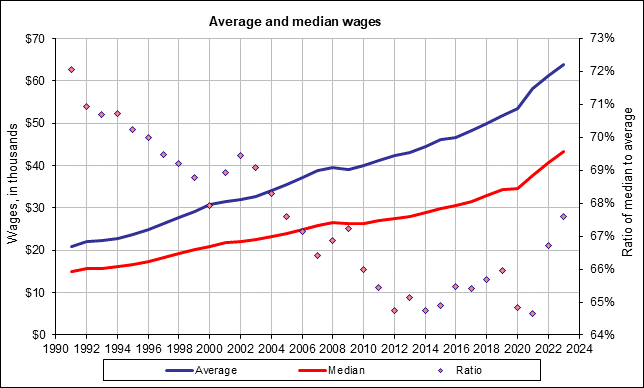Tuesday, August 29, 2006
As usual, he beat me to it
 Median wages are unusual to use, and more so when you are looking only at cash wages instead of total benefits.
Median wages are unusual to use, and more so when you are looking only at cash wages instead of total benefits.The graph on the left is median average and median wages measured as net compensation, from the Social Security Administration that uses the average number to set cost of living adjustments for Social Security benefits. It specifically excludes any payment to a worker that is not reported as taxable income on the worker's W-2. The ratio of median to average has declined as seen in the graph -- so EPI and the NYT are using the less-favorable number to make their comparisons. But when you look at labor's share of GDP, Roberts points out, the ratio of the wage bill to GDP is still at 70%. It's just that more of that share is being paid in non-taxable portions than before.
David Altig points out that the ratio of GDP going to capital could rise without it being paid by a reduction in labor's share, since indirect taxes and subsidies get in the way. But that's probably not what is going on here. Roberts makes the fine conclusion:
What keeps my wages high (and yours) is our alternatives. Is there any evidence that workers have fewer alternatives than they once had? If anything, workers are more mobile today than ever. What sets workers wages are the wages of those alternatives. That depends, generally, on our skills, our knowledge and our drive and discipline�human capital and how well we are able to apply it. Workers are better educated than ever. That is why I believe that compensation, properly measured, is higher than it was five or ten or twenty or thirty years ago.The return on education keeps growing and people keep coming in larger numbers to higher education. Why would they do that in a world of falling wages? Why would you invest in human capital if its return was negative? You wouldn't.
Tim Worstall comes at this a little differently and thus gets only close to the answer:
So, yes, productivity has been rising strongly, wages have not been. This sad state of affairs will continue while productivity grows faster than GDP. It explains all of the observed facts, without recourse to some conspiracy theory about screwing the workers, orthe rich keeping it all for themselves.That leaves a very important question -- how is it that productivity has grown so much? The problem is, of course, that most people measuring productivity are measuring just the share of output growth that is not attributable to an increase in labor hours. Today also happens to mark the release of the first estimates of multifactor productivity for 2005. It shows a slowdown in MFP versus 2003 and 2004. Output per hour rose 2.6% in 2005, but 0.7% of that was due to more intensive use of capital (for which its owners should expect some return) and another 0.1% due to changes in the education and experience of the workforce. In short, the capital per worker ratio rose by 2.3% -- there was an increase in capital intensity. That accounts for almost a third of the increase in productivity. (Looking at the underlying data too quickly tells me the cost of labor has risen faster than the cost of capital, thus inducing some technological substitution towards more capital-intensive production.)
But any fool can come up with a number to prove his point. Economists should study people's behavior before looking up their spreadsheets. If wages were so stagnant, why would people invest in their 'wetware'?









